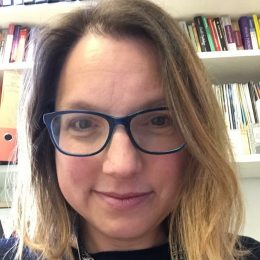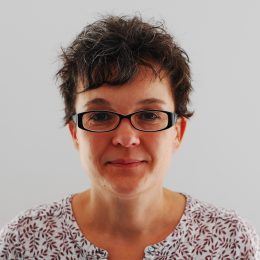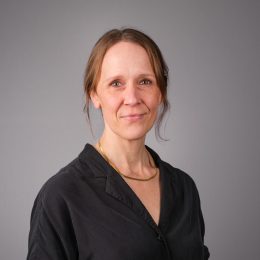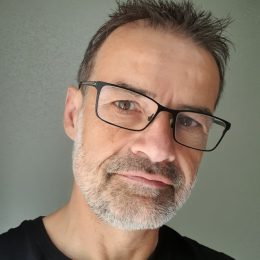How Do You Move? Improving the communication of the national physical activity guidelines
The UK Chief Medical Officers (CMO) published new guidelines on physical activity in September 2019. Based on a comprehensive review of the latest research, they recommend how much physical activity we should do and what types most benefit our health.
In the past, physical activity guidelines have been tricky to understand and difficult to follow. This project, led by the ARC West team alongside collaborators Knowle West Media Centre (KWMC), aims to make them more meaningful and useful for members of the public.
The How Do You Move? project had three parts:
- First, working with four community groups in Bristol, we ran workshops to understand what physical activity means to them, and how best to communicate physical activity messages to their community.
- Our second piece of work developed five emotive, first person case studies that illustrate how people have managed to be active, co-produced with members of the public. KWMC worked with them to create short films based on four of the case studies.
- Lastly, we produced recommendations for communications and healthcare professionals on how to improve how physical activity messages are presented to the public. These include information about the language people prefer and the best ways to share physical activity messages, for example via videos, pictures, or media campaigns.
The Brigstow Institute, University of Bristol has funded the first two stages of this project.
What we did
We worked with KWMC and Mufti Games to develop fun, interactive workshops that explored different groups’ attitudes to physical activity and how messages about physical activity should be communicated. Four workshops were run for the following groups of people living in under-served communities in Bristol:
- Children and young people aged 10-15 years
- Older adults
- Somali women
- Adults
Researchers then analysed the data produced from the workshops.
To develop the case studies and videos, we found six people with interesting physical activity stories to tell. Some of them were participants in the workshops, others were individuals already known to the project team. The participants were interviewed in an informal setting: some were even interviewed on a walk to bring physical activity into the process. The interviews were developed into case studies written in the first person, through several iterations. Four case studies went on to be developed into short films.
What we found and what this means
We have published our findings from the four community workshops. The workshops were very useful in identifying the preferences of local community groups about physical activity messaging. We found many similarities between the four groups, but we noted some differences too.
One consistent finding was the need to highlight the wider benefits of physical activity. Rather than just emphasising the benefits to our physical health, such as reducing risk of disease, we should also promote the mental health benefits and the social benefits. Having fun and spending time with friends were often primary reasons for being physically active.
The second key finding was the need not to confuse “exercise” and “sport” with physical activity. The terms “exercise” and “sport” tended to have lots of negative associations for many participants. When communicating about physical activity, it is important to make it clear that physical activity is about movement, and there are many ways in which we can move. For some, gardening, dancing, and walking were all important forms of physical activity, and it is important for people to know that these count towards their recommended daily physical activity.
To help professionals talk about physical activity in the future with the public, we boiled our findings down to 10 core recommendations. These recommendations are purposefully broad, but there is more detail in the published paper about the preferences of young people, of adults, of older adults, and of Somali women.
10 ways to improve your physical activity communication: the Bristol recommendations
- Work with multi-disciplinary teams, and ensure (social) marketers are involved
- Understand, and work with, your target audience to develop tailored messages
- Keep language simple. You may not need to include the physical activity guidelines!
- Promote the benefits of physical activity, including physical, mental and social health
- Identify influential and trustworthy individuals to deliver the message
- Use different mechanisms (eg posters, social media, TV) to spread a consistent message
- Terminology matters. Physical activity is more than just exercise and sport
- Consider how resources can be pooled between organisations to promote a consistent message
- Documents for healthcare professionals (eg infographics) are not designed for the public
- Reflect on current physical activity messages, and how they might be interpreted by the public
In the case studies part of the project, we worked closely with six members of the public, four individuals and one couple, to develop five physical activity stories. In collaboration with the team at KWMC, four of the stories were made into short films.
Abiir’s story
Abiir lives in Easton in Bristol and has four young daughters. She spent her childhood in Germany, and is now a keen advocate for increasing cycling in the Somali community. Read Abiir’s story.
Ben’s story
Ben is a community activist in Bedminster, Bristol. He’s retired and spends a lot of his time working with local people to improve the neighbourhood, particularly to make it more pleasant and accessible for walking. Read Ben’s story.
Lesley’s story
Lesley works full-time managing a large university department, as well as juggling family life with her partner, two teenage daughters and two dogs. She came to running later in life and is now an active part of the running community in Staple Hill, Bristol. Read Lesley’s story.
Vince’s story
Vince lives in Bedminster in Bristol and has strong links to Knowle West and Hengrove where he grew up. Despite health issues, he’s used the support available in South Bristol to help maintain both his mental and physical wellbeing. Read Vince’s story.
Stephen and Nikki’s story
Stephen and Nikki are husband and wife and both work in the NHS. They have experienced physical and mental health challenges in the last 10 years. Physical activity has helped improve their wellbeing. Read Stephen and Nikki’s story.
The films were screened for the first time at a launch event on 22 January 2020. They have been circulated via social media and are available to view on YouTube.
What next?
Our findings have already been shared with the WHO Physical Activity guidelines group and are feeding into the work of the CMO physical activity guidelines development group.
Papers
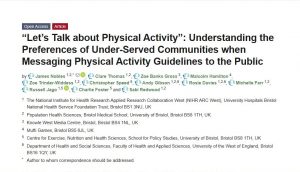
“Let’s Talk about Physical Activity”: Understanding the Preferences of Under-Served Communities when Messaging Physical Activity Guidelines to the Public
Read the paper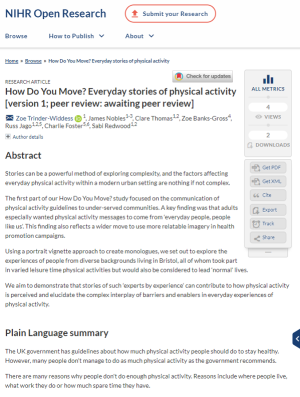
Lead collaborators
- Dr James Nobles, Leeds Beckett University
- Zoe Banks Gross, Knowle West Media Centre
- Charlie Foster, University of Bristol
ARC West Staff
Dr Clare Thomas
Research FellowDr Michelle Farr
Senior Research Fellow, Qualitative ResearchProfessor Sabi Redwood
DirectorZoe Trinder-Widdess
Head of CommunicationsDr Andy Gibson
Patient and Public Involvement LeadProfessor Russ Jago
Co-Theme Lead, Public HealthPartners on this project
University of Bristol
The University of Bristol is internationally renowned and one of the very best in the UK, due to its outstanding teaching and research, its superb facilities and highly talented students and staff. Its students thrive in a rich academic environment which is informed by world-leading research. It hosts the Elizabeth Blackwell Institute for Health Research.
